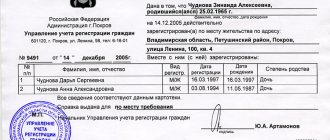What is a title document for real estate?
From the name of this type of documentation it is easy to understand that it establishes the right to real estate. It specifies what belongs to a person and on what basis. We are talking about those official papers that are drawn up during the transaction.
For example, when purchasing real estate, a sales contract is traditionally concluded. If we talk about the primary title documents for a cooperative apartment, then this is a certificate of payment of the share contribution. Further, on its basis, it is necessary to obtain a Certificate of State Registration of Property Rights.
Is the act of acceptance and transfer of an apartment a document of title?
The acceptance certificate is not included in the list of this documentation. With the help of the transfer and acceptance certificate, you can only prove that all obligations have been fulfilled and that the transfer of rights has taken place. Therefore, there is no need to register the transfer and acceptance act. Thus, the sale procedure can take place without a transfer and acceptance certificate.
Types of title documents for an apartment
Below is a list that is relevant for people who want to know what types of title documents for real estate exist.
List of types of documentation establishing the rights of the owner:
- Agreements: on the transfer of residential space into ownership during privatization, purchase and sale, rent, exchange, donation, exchange of property for rent, equity participation;
- Evidence: ownership of a share in the property of the spouses, inheritance by law;
- Certificate from the housing cooperative about the paid share;
- The original court decision or a copy of the court decision.
Each official paper is defined on a case-by-case basis. In addition to this type of documentation, it is necessary to provide the notary with the owner’s title documents during the transaction.
Title documents for an apartment - how to get them?
These official papers for the owners are concluded during the transaction. Depending on the type of transaction, you need to find a standard sample of the relevant agreement and fill it out. However, it is easier to use the services of a notary, especially since notarization of the right to transfer ownership of real estate is a mandatory requirement.
Registration of ownership: documentation for the land plot
- certificates of the right to inherit property (notarized);
- acts or agreements for the transfer and acceptance of property rights (donation, exchange, privatization, purchase and sale, etc.);
- acts that were issued by local self-government bodies or other relevant bodies;
- valid decisions of judicial institutions (only those that are considered to have acquired legal force), this includes a settlement agreement that is approved by the court;
- various orders, decisions, decrees and acts of relevant government agencies, as well as local administrations (officials) on the allocation or provision of land. However, in this case, it should be taken into account that these certificates themselves (registration, entry into the register, and similar materials), which were issued by the BTI or local government administrations, cannot be considered legal. They should only be attached to all other documentation;
- contracts and other transactions that are carried out in relation to this type of real estate and have the status of establishing title;
- certificates or acts of privatization of the plot, issued in accordance with the current legislation at the place and at the time of registration of privatization;
- various acts that were in force at the time of significant legal actions;
- decision to provide land for use for an indefinite period. You should know that in cases where such an allotment was leased and also transferred, by decision of local authorities, into the ownership of a citizen does not belong to this type of documentation, but is considered as the basis for drawing up an appropriate agreement. Such a decision becomes legal only after the conclusion of a new agreement and its registration with the necessary government agencies.
We recommend reading: Enter into inheritance rights without a will
Certificate on the contents of title documents for the apartment
If the main document establishing the right is missing for some reason, then it is necessary to order a certificate of the contents of the title documents for the property. It will confirm the fact that the owner has the apartment legally.
It states:
- The body from which the Unified State Register received information about registration;
- Address of the property;
- Cadastral number;
- Full information about the owner.
Where can I get a certificate of the contents of title documents for real estate?
This certificate is issued by the authorities involved in the registration of rights to real estate. The list of powers of these bodies includes issuing information about registered rights. And after receiving a request from the owner or another person, specialists with access to the Unified State Register contact other authorities.
Documents on rights to land plots (title and title certifying documents)
This is due to the fact that, by virtue of a direct prescription of the law, the rights to a land plot are subject to state registration, i.e. after the conclusion of an agreement, the adoption of a court decision or the adoption of a decision by an authorized body to grant the right to a land plot, its state registration follows as a special action, as a special legal fact, without which rights to a land plot do not arise.
We recommend reading: Registration of ownership of a summer cottage
The title documents for the apartment are lost - what to do?
If the certificate of registration of rights has been lost, then you should contact the FSGR office operating in your area by writing a corresponding application. You can easily obtain copies of various agreements from this Federal Service, because they are all stored in the archives. After this, you only need to certify duplicates of official papers that were lost.
03.07.2010
Form 3
- a certificate confirming the presence or absence of rights to real estate in the requested subject (usually required for the authorities for registration and distribution of living space for understanding).
List of documents provided by applicants for issuing certificates of absence or availability of property, certificates of apartment ownership:
1) identification document of the applicant and its copy, in particular:
passport of a citizen of the Russian Federation (for citizens of the Russian Federation over 14 years of age living on the territory of the Russian Federation);
certificates issued by civil registry authorities: birth certificate of a minor, adoption certificate (in case of filing an application on behalf of minors under the age of 14);
2) a document confirming the authority of the representative to act on behalf of the appropriate person (that is, the person to whom the certificate can be issued) and its copy (notarized power of attorney);
3) a document confirming payment of a fee for issuing a certificate (check the amount of the fee with a specialist);
4) if the applicant has property, documents are provided establishing the existence, origin, termination, transfer, rights and copies thereof.
5) marriage certificate and its copy.
If the issuance of a certificate is applied for by an heir, the transfer of rights to whom was not registered on the date of submission of the application for the certificate, then a document is submitted confirming that the applicant is the proper person (the person to whom the certificate can be issued).
A document issued by a notary (certificate, notice, etc.) and confirming this fact can be considered as a document confirming that the person applying for the certificate is the heir of the copyright holder.
The Federal Law on the Registration of Rights to Real Estate and Transactions with It tells us that the unified state register of rights contains information about existing and terminated rights to real estate objects, data about these objects and information about right holders.
An integral part of the Unified State Register of Rights are files that include title documents for real estate and document books. A file of title documents is opened for each piece of real estate.
As for the validity period of this certificate (not established by law), based on the essence of such a certificate, there is no period as such, since the information is provided by the Unified State Register of Rights to Real Estate and Transactions with Them on the day the information is issued. But as a general rule, it is valid for 3 months.
All documents received for registration of rights to the specified object are placed in the case. The document books contain data on: documents accepted for registration about the real estate property, copyright holders, registered rights and applicants; issued certificates of state registration of rights; extracts and certificates from the Unified State Register of Rights, about other documents.
29.06.2010
Certificate on the contents of title documents
According to the Federal Law “On state registration of rights to real estate and transactions with it”, obtain a certificate from the Unified State Register of Rights on the contents of title documents
Only authorized persons may enter the real estate property.
25.06.2010
Inventory. What and how.
Inventory
— checking the availability of property listed on the balance sheet of the enterprise according to accounting data. Inventory is carried out by counting, describing, weighing, mutual reconciliation, and evaluating the identified funds. There are partial, periodic, complete and selective inventories.
Many organizations are required to take inventory monthly, but all businesses must take inventory annually. According to Chapter 25 of the Tax Code of the Russian Federation, failure to comply with this requirement is equivalent to the lack of accounting. Serious consequences can also result from incorrect registration of inventory results.
Inventory is not only an important general business activity, but also an element of accounting policy. According to paragraph 3 of Art. 6 of the Law on Accounting, when forming an accounting policy, in addition to the working chart of accounts, forms of primary accounting documents, document flow rules, the procedure for conducting an inventory of the organization’s property and obligations is also approved. It is necessary to pay attention to the importance of this provision, since in many organizations (especially in the field of small businesses) inventories are either not carried out at all or are carried out in violation of established rules, which leads to the formal filling out of inventory lists and acts according to the accounting register.
To carry out an inventory, an appropriate order is issued, which appoints members of the inventory commission and determines the timing of the inventory. Members of the inventory commission check the availability of items and materials specified in the inventory and comparison sheet. Primary documents for recording inventory results are used to verify the completeness and accuracy of accounting during a full or partial inventory of the property and financial assets of an enterprise. Based on these documents, the inventory commission determines to what extent the content of accounting data and primary documents corresponds to the actual value of the property.
The main regulations governing the inventory procedure are:
Accounting Law;
Regulations on accounting;
Guidelines for inventory of property and financial liabilities, approved by Order of the Ministry of Finance of Russia dated June 13, 1995 N 49 (hereinafter referred to as Guidelines for Inventory).
In accordance with these documents, as well as Resolution N 835, for the preparation of primary documents compiled during the inventory, it is necessary to use standard interdepartmental forms of primary accounting documentation approved by the State Statistics Committee of Russia.
Resolution No. 88 introduced the following forms for documenting inventory results:
N INV-1 “Inventory list of fixed assets”;
N INV-1a “Inventory list of intangible assets”;
N INV-2 “Inventory label”;
N INV-3 “Inventory list of inventory items”;
N INV-4 “Act of inventory of goods and materials shipped”;
N INV-5 “Inventory list of inventory items accepted for safekeeping”;
N INV-6 “Act of inventory of payments for inventory items in transit”;
N INV-8 “Act of inventory of precious metals and products made from them”;
N INV-8a “Inventory inventory of precious metals contained in parts, semi-finished products, assembly units (assemblies), equipment, devices and other products”;
N INV-9 “Act of inventory of precious stones, natural diamonds and products made from them”;
N INV-10 “Act of inventory of unfinished repairs of fixed assets”;
N INV-11 “Act of inventory of future expenses”;
N INV-15 “Cash Inventory Act”;
N INV-16 “Inventory list of securities and forms of strict reporting documents”;
N INV-17 “Act of inventory of settlements with buyers, suppliers and other debtors and creditors”;
Appendix to form N INV-17 “Certificate for the act of inventory of settlements with buyers, suppliers and other debtors and creditors”;
N INV-18 “Comparison statement of the results of the inventory of fixed assets, intangible assets”;
N INV-19 “Comparison sheet of inventory results of inventory items”;
N INV-22 “Order (decree, order) on conducting an inventory”;
N INV-23 “Logbook for monitoring the implementation of orders (decrees, instructions) on inventory”;
N INV-24 “Act on control verification of the correctness of the inventory of valuables”;
N INV-25 “Register of control checks of the correctness of the inventory”;
N INV-26 “Record of results identified by inventory.”
In accordance with the Methodological Instructions for Inventory, the inventory is carried out in several stages. At each stage, relevant primary documents are drawn up. In this case, an order to carry out an inventory is first issued (Form N INV-22), which is registered in the journal for monitoring the implementation of orders to carry out an inventory (Form N INV-23). Then inventory records or acts are filled out, which contain information about the actual availability of property and the reality of recorded financial obligations (forms N INV-1, INV-1a, INV-2, INV-3, etc.). The next step in the inventory process is to compare the results identified during the audit with the data reflected in the accounting accounts.
At the same time, to reflect the results of the inventory of fixed assets, intangible assets, inventories, finished products and other material assets, matching statements are compiled (forms N INV-18, INV-19).
To record the results of the inventory of unfinished repairs of fixed assets, future expenses, the availability of funds, securities and forms of strict reporting documents, unified registers can be used, which combine the indicators of inventory lists (acts) and matching statements (forms N INV-10, INV- 11, INV-15, INV-16).
Upon completion of the inventory, control checks of its correctness can be carried out. The results of such checks are formalized in an act (Form N INV-24) and are recorded in the logbook of control checks of the correctness of the inventory (Form N INV-25). At the last stage, the data from the results of the inventory carried out in the reporting year are summarized in a statement of records of the results identified by the inventory (Form N INV-26). Inventory documents are stored for at least 5 years.
Grounds on which inventory results may be invalidated:
Absence of a financially responsible person during the inventory;
Absence of at least one commission member during the inventory;
Unspecified corrections in inventory records;
Inventory lists are not drawn up in accordance with the requirements for these documents.
Each owner and co-owner of the property must have title documents for the property so that no problems arise in confirming these rights. According to its principle, such documentation is divided into title-establishing and confirming ownership rights. Based on the former, legal ownership of the object arises, on the basis of the latter, the owners are protected at the legislative level and can enter into all kinds of transactions for the alienation of real estate.
There are the following types of title documents:
As this list shows, neither the certificate of state registration of proprietary rights, nor an extract from the unified state register refers to title documents.
Dear readers!
Our articles talk about typical ways to resolve legal issues, but each case is unique. If you want to find out how to solve your specific problem, please contact the online consultant form on the right →
It's fast and free!
Or call us by phone (24/7):
Title and title documents for land
N 177 “On approval of the forms of a certificate of ownership of land, a lease agreement for agricultural land and an agreement for the temporary use of agricultural land”, which has become invalid) with the mandatory attachment of a cadastral plan (map, passport) of the site; 2) Certificate of ownership of land (issued, among other things, by Decree of the President of the Russian Federation of October 27, 1993 No.
Certifying documents include documents that confirm the registration of rights to an object. For example, a certificate of state registration of rights, a certificate of housing rights, a certificate of land ownership, etc. To register inheritance rights, both title and title documents are required.
Confirmation of rights
Understanding the two existing categories is actually not difficult, since title documents for real estate are those on the basis of which rights to property arise, and confirming documents, as is clear from the definition, confirm them.
Papers confirming the legal right to real estate:
Each of these papers has legal force and is an integral part of the title documents for real estate. All accompanying documents must be up to date, and the owner must monitor this independently. For example, if land surveying was carried out, this must be reflected in the documents with changes made to a single database.
Title and title documents for land
. which were received during the privatization of land ownership, for example: a certificate of ownership. Agreements can be: purchase/sale; barter; donations; some other agreements indicating the transfer of ownership of land; Documents that are not title-establishing, but confirm rights to land.
Title-establishing documents are “primary source documents”, on the basis of which a title certifying document (certificate of state registration of rights) is issued. Title documents are the primary basis for state registration of land rights.
Acquisition through purchase
When it comes to purchasing real estate based on a purchase and sale transaction, you need to be extremely attentive to the documents and check their legal purity. It is important to know what exactly should ultimately remain with the new owner of the property in order to reduce the risk of possible legal claims from outside. In addition, it is necessary to pay attention to the timing, how long the seller owned the object and how it was received. Such information speaks volumes and helps to avoid big troubles.
After you have figured out what a document of title is and what it can be, you should consider the features of the papers that are transferred to a citizen when purchasing a real estate property, namely:
- The transaction agreement must contain personal signatures of all parties and reliable details. They must be checked with your passport and other documents before signing;
- There cannot be any inconsistencies between the information indicated in the papers for the same object. If they exist, this may indicate fraud and big troubles in the near future;
- It is highly advisable to update the cadastral passport and plan every five years.
Whatever real estate we are talking about, if the seller is officially married at the time of sale, you should make sure that the property is not jointly owned. If this is the case, you should require the written and notarized consent of the second spouse to carry out such a transaction.
Acquisition through court
It also happens that you have to establish your right of ownership by filing a claim in court, that is, the basis for the emergence of ownership is a court decision. However, it will not be positive if the applicant does not have one of the following title documents:
The key feature of establishing rights through the court is that the court decision is indisputable and all claims will cease. This will not only protect the current owner, but also the next one if this object is transferred to him as a result of any transaction or inheritance.
Features during alienation
Some of the documents of title to real estate must be notarized. These include copies of personal passports, if we are talking about co-ownership, copies of certificates of ownership, etc. Despite the fact that the purchase and sale agreement is not required by law to be notarized, it will never be superfluous. The signature and seal of a notary serves as an additional guarantee against illegal claims from outside and accusations of the owner that he received the object illegally.
When it comes to the alienation of real estate that is just being transferred or has become the property of a new owner, it is also necessary to obtain an extract from the management company about the status of personal accounts in order to find out if there are any debts for utilities. It won’t be superfluous to take it and attach it to the general package of papers. It will serve as confirmation that the property does not have any additional persons having the right to use it. This is especially important when it comes to housing.
An additional guarantee confirming ownership rights is an extract from the Unified State Register of Real Estate. It is worth keeping in mind that it can be ordered by strangers who decide to check who actually owns the object.
Lack of required papers
As practice shows, most citizens do not think about title documents until the issue becomes an issue. It often turns out that some papers are out of date or completely missing for some reason, be it lost or damaged. Be that as it may, they need to be restored.
If no transactions were made with real estate for many years, there were no inheritances, there was no actual transfer of rights, then citizens may be faced with a situation where the property was received before 1998 and after that no one really dealt with the documents. In this case, you will need to visit the territorial Bureau of Technical Inventory, where such old data is stored. Information about all objects acquired later than this time is available in Rosreestr. Making a request there will not be difficult, since a single database is accessible from any locality on the territory of the Russian Federation. To confirm your right, you need to order an extract from the Unified State Register of Real Estate. Next, you should start restoring other missing papers.









